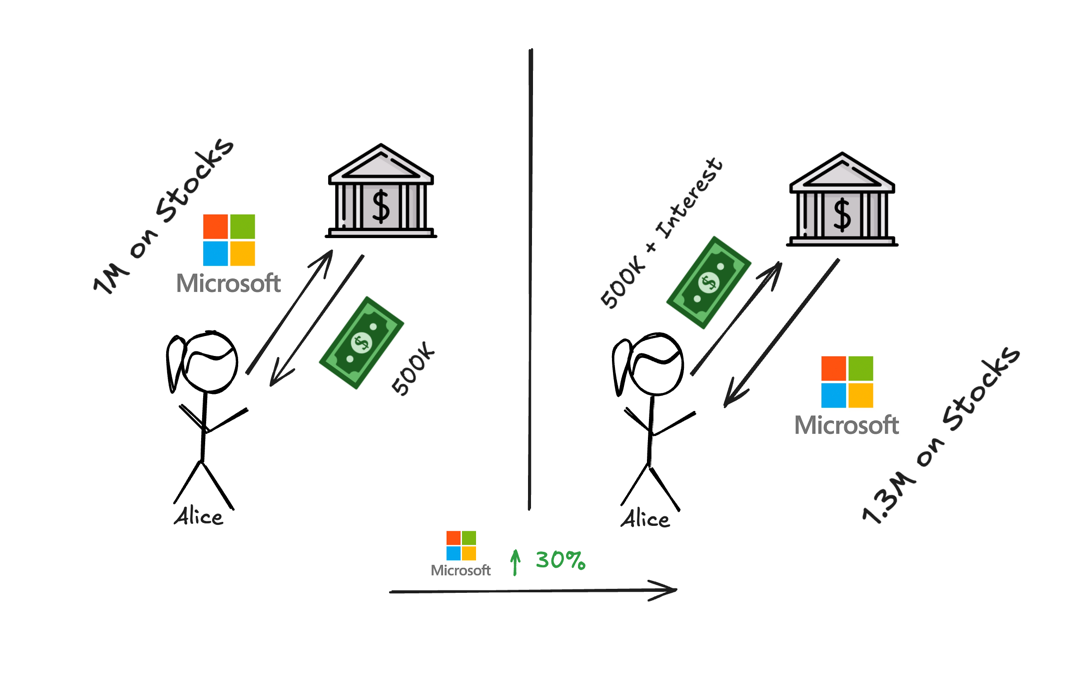- Home
- Case Studies
- Stocks: Borrowing Against Equities Like the Ultra-Wealthy
Stocks: Borrowing Against Equities Like the Ultra-Wealthy
Use your stock portfolio as collateral to access cash while retaining market exposure.
Strategy Overview
Description of the Use Case
High-net-worth investors often leverage their appreciated stocks to secure low-interest loans. This provides liquidity for other investments or personal expenses while leaving their equities intact to capture further gains.

Step-by-Step Process in Traditional Finance
The journey from stock ownership to liquidity
1. Portfolio Review
A broker evaluates a $1M stock portfolio with blue-chip shares.
2. Loan Request
The investor requests a 50% LTV securities-backed line of credit for $500k.
3. Collateral Agreement
The lender holds the shares as collateral but the investor keeps dividends.
4. Deploy Capital
The borrowed funds go to real estate or business ventures.
5. Monitor Appreciation
Over 2 years the portfolio rises to $1.3M (14% annual growth).
6. Repay Loan
The investor repays the $500k plus 10% interest (5% annually) using profits while keeping the stocks.
7. Rebalance
If markets dip, extra shares or cash are added to maintain LTV.
Benefits of This Model
Liquidity Without Selling
Access cash for new opportunities while still owning the shares.
Tax Efficiency
Borrowing against stocks doesn't trigger capital gains.
Diversification
Use funds for other asset classes like real estate or startups.
Retain Market Upside
Stay invested as equities potentially appreciate.
Fast Access
Lines of credit can fund within days from major brokers.
Risks of This Model
Understanding the risks of stock-backed loans
Market Volatility
Falling prices can trigger margin calls—maintain a cushion.
Interest Costs
Rates are low but add up if markets stagnate.
Over-leverage
Large loans relative to portfolio can lead to forced liquidation.
Dividend Cuts
Lower dividends may affect repayment plans.
Tax Changes
Future regulations may reduce advantages.
Real-World Examples
A tech executive borrowed $500k against a $1M stock portfolio via Morgan Stanley. By 2025, the portfolio appreciated to $1.3M. He repaid the loan using business profits, keeping his stocks and capturing further gains. Similarly, Elon Musk has pledged over 238 million Tesla shares as collateral to secure personal loans—allowing him to access liquidity without selling equity. This strategy preserves ownership, voting power, and upside potential.
Unlock Liquidity Without Selling
Stock-backed loans let you access cash while retaining ownership and potential upside. They're particularly valuable for concentrated positions or when you want to defer capital gains taxes.
Explore PlatformsSupporting Quotes
Securities-based lines of credit offer investors liquidity while keeping their portfolios intact.
high
Borrowing against a portfolio lets you meet short-term cash needs without interrupting your investment strategy.
high
Using securities as collateral may provide a lower-cost alternative to personal loans or credit cards.
high
The rich use asset-backed lines of credit to avoid selling and to fund investments.
high
More Case Studies
Top Lending Platforms
Choose a provider and start borrowing today.
Some links are referrals that help support the site.